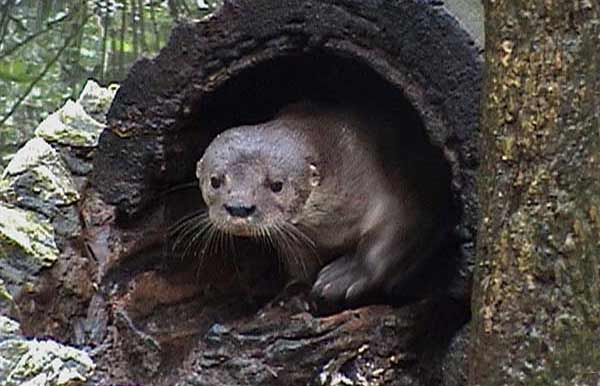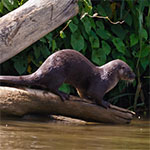- Home
- Accommodation
- Activities
- Area Info
- Maps
- Photo Galleries
- Real Estate
- Travel
Otter
Weight/Height: They are small animals that average about four feet in length and up to 30 pounds. The Otters have a length from head to body, 21.75 to 31.5 in (55 to 80 cm); and tail, from 11.75 to 19.75 in (30 to 50 cm).
Life Span: They can live up to 23 years in captivity.
Habitat: Sea Otters live in coastal areas and eastern and western Pacific Ocean including Costa Rica.
Otters are mammals that exist both on land and water (both sea and/or river). Due to their striking resemblance with beavers, these creatures often face the mistaken identity crisis. They can generally be found living on land that is in very close vicinity to a water body. In Montezuma, they have been spotted in the Rio Montezuma or Rio Lajas in Cabuya. Visitors can mostly spot them in fresh water streams, rivers and by the sea.
 The neotropical otter lives in evergreen forests, savannas, pantanals, deciduous jungles and llanos, or virtually any habitat that’s in the vicinity of a natural water body. This cuddly looking creature also has a liking for rapid streams, and clean, fast flowing rivers and is rarely spotted near stagnant rivers. The neotropical otter is a solitary creature and feeds on fish and other river aquatics. They generally live and hunt alone, though a mother can be spotted caring for her new borns.
The neotropical otter lives in evergreen forests, savannas, pantanals, deciduous jungles and llanos, or virtually any habitat that’s in the vicinity of a natural water body. This cuddly looking creature also has a liking for rapid streams, and clean, fast flowing rivers and is rarely spotted near stagnant rivers. The neotropical otter is a solitary creature and feeds on fish and other river aquatics. They generally live and hunt alone, though a mother can be spotted caring for her new borns.
Neotropical river otters live near rivers and other waterways. They prefer living inside dens in natural structures, such as caves, or shallow self-made shelters no deeper than 20 inches. A majority of the otter species construct dens with at least one underwater entrance.
In general, the territory of the female otter ranges from 4 to 50 miles of riverfront, while that of the male is a little larger. The territories don’t overlap. In some areas, there is a clear hierarchy with the more dominant animals occupying the largest and most important stretches on river banks. Neotropical river ottersin Costa Rica can be spotted along almost all major rivers including the Sarapiqui, Puerto Viejo, Sierpe, Tempisque and Tortuguero.
Their food comes from both the land and water. They feed on fish in the water and small birds when they are on land. Currently about 13 species of Otters have been identified. The otters are distinguished from other sea mammals by their lengthy and slim bodies, with short appendages and webbed paws. The specific species of otter found in Costa Rica is called the neotropical otter. Since they can survive on a variety of food types, they can be spotted in a range of habitats and are mostly found in areas near fresh water bodies.
 They are Carnivores and usually survive on aquatic animals such as fish and other invertebrates, aerials and tiny mammals. The body of the Otter allows them to undertake activities in both water and land. Owing to this, wildlife researchers consider that the otter’s ability to adapt to different environments and different types of foods allow it to thrive in multiple habitats with ease.
They are Carnivores and usually survive on aquatic animals such as fish and other invertebrates, aerials and tiny mammals. The body of the Otter allows them to undertake activities in both water and land. Owing to this, wildlife researchers consider that the otter’s ability to adapt to different environments and different types of foods allow it to thrive in multiple habitats with ease.
Skilled fishermen, river otters forage for fish and other preferred foods underwater, where they can hold their breath for up to eight minutes. Researchers believe that this species consumes an incredible 15-20% of its body weight each day, or two to four pounds per day, per animal. Their preferred diet includes mollusks, fish, aquatic invertebrates and crustaceans such as shrimp, crayfish and crabs; they are also known to hunt aquatic birds.
Owing to their plentiful and rich fur coating, these animals are extremely susceptible to poaching .
The neotropical otter does not fear approaching humans which has further put its existence in grave danger. It doesn’t retreat or try and escape an approaching human which makes it easy for poachers and hunters to track it down and kill it to sell its much in demand fur in the international fashion arena. In the 70’s itself, more than 30,000 otters were killed annually for their fur. Owing to this, the neotropical otter has consistently found a mention in the endangered animals list since 1999.
Otters breed all through the year and their gestation period lasts for anywhere between 60-86 days. The new born is cared for by the mother, the father, and all the offspring help the parents in the process of caring for the new born. Female otters reach their sexual maturity at about two years of age, while males get there at about three years of age. When it’s a month old, the otter is capable of coming out of the cave on its own, while at 2 months it learns how to swim. The otter lives with its family for at least year to ensure its safety.
For More Information
http://otteradrift.com/2014/01/mammals-of-costa-rica-and-panama/
http://www.gapyearblog.info/blog/2014/1/2/the-secret-life-of-otters.html
http://costarica.com/wildlife/neotropical-river-otters/
Great Stuff

Clandestina Restaurant
My new favorite restaurant, Clandestina is not to be missed by food lovers staying anywhere near to Montezuma. Established in March 2015, Clandestina is the new kid on the block. The Oregon/Tico collaboration is a winner among locals and travelers alike, with artisan craft beers, made onsite by Butterfly Brewing Co. and delicious, exciting […]











